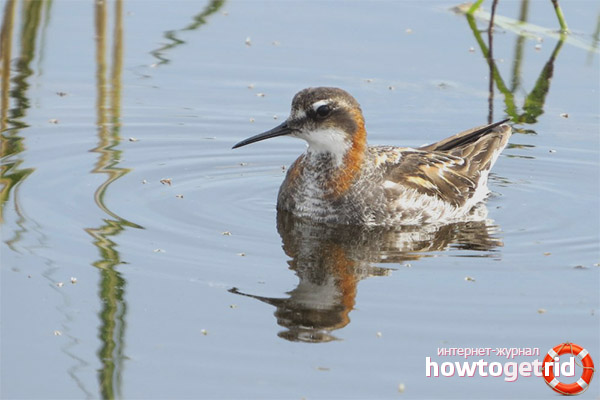The content of the article
The round dipper is a species of feathery, belonging to the order of charadriiformes and the family of snipe. These birds are absolutely small in size. The length of their body reaches only 19 centimeters maximum, and body weight is usually not more than 45 grams. Wingspan varies from 32 to 41 centimeters. Today in the world there are about 95 thousand pairs of blue-fingered blue-headed ducks.
Description of the appearance of the spear
The round dipper is the smallest of all the varieties of pearl beetles. In birds of this species is black and thin beak, slightly compressed from the sides. Also characteristic feature of these birds are leathery rims on the fingers. During the nesting period, birds acquire a special color. The plumage of males at this time becomes more pale, gray-black, the area of the neck and chin of the usual white. The neck on both sides has small portions of red feathers.Breast and sides covered with gray feathers, belly - white. In females, the color is brighter and sharper, in winter the plumage becomes light gray.
Where do round-fingered dwells live?
Their finch nests are usually settled in the tundra, as well as in the forest tundra. Basically, as a place to live, these birds choose the shores of lakes, as well as marshlands. At the time of wintering birds move to other territories, but they can be found most often in the open sea or on the coast.
How do babies live and behave?
During the nesting period, these birds usually create colonies of a small number of individuals.Nests are mainly settled in low plants, as well as in moss. As a litter, these birds use different leaves and stems. The period of egg laying at the spearheads usually falls on time from the beginning of May to July. On average, females lay 4 eggs in one laying, eggs have an olive tinge and dark spots. After the females lay their eggs, they immediately fly south. Hatching eggs predominantly males, in time, this process takes up to three weeks. Broods have only one per year. After hatching, the chicks independently feed themselves. Already after 20 days, the offspring can fly and swim independently. Males leave offspring as soon as chicks begin to move independently. After this, broods tend to fall apart.
A distinctive feature of this species of birds is how easily they behave in flight. Ditches, besides, love to float. The round-nosed swimmers have a very creaky voice, and they are distinguished by their trust. In the menu of these birds are mostly invertebrates that live in the water. Interestingly, these birds are excellent swim, and can also easily dive due to the rims on their fingers.The process of extracting food comes down to the fact that the little pearl rotates around its axis and stirs up the water around itself. This greatly facilitates the process of capturing invertebrates.
Relatives of round-nosed swimmers
The most common relative of round-fingered beetles is the flat-nosed drift. This species is distributed mainly in the territory of the extreme Arctic region. Unlike the round-nosed, this type of fluffy has a large size and body weight, as well as a different color. Flat-footed individuals are covered with chestnut and brick-colored feathers in the neck and lower body. The beak of birds has the shape of a cone; it is rather short and usually yellow.To meet these birds occasionally can be in Italy during the wintering period.
Video: Phalaropus lobatus












To send